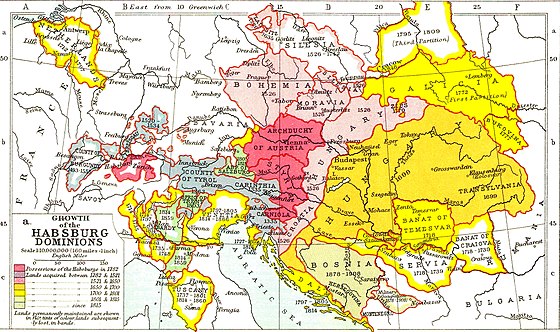The Habsburg Monarchy (German: Habsburgermonarchie) or Empire, occasionally also styled as the Danubian Monarchy (Donaumonarchie), is an unofficial appellation among historians for the countries and provinces that were ruled by the junior Austrian branch of the House of Habsburg until 1780 and then by the successor branch of Habsburg-Lorraine until 1918. The Monarchy was a composite state composed of territories within and outside the Holy Roman Empire, united only in the person of the monarch. The dynastic capital was Vienna, except from 1583 to 1611,[3] when it was moved to Prague. From 1804 to 1867 the Habsburg Monarchy was formally unified as the Austrian Empire, and from 1867 to 1918 as the Austro-Hungarian Empire
The head of the Austrian branch of the House of Habsburg was often elected Holy Roman Emperor until the Empire's dissolution in 1806; from 1415 until the empire's dissolution in 1806 only Charles VII of Bavaria was not a Habsburg ruler of Austria.[6][7] The two entities were nevercoterminous, as the Habsburg Monarchy covered many lands beyond the Holy Roman Empire, and most of the Empire was ruled by other dynasties. The Habsburg Monarchy did not usually include all the territories ruled by the Habsburgs. The senior branch ruled Spain until 1700, but it is not usually included in the definition of "Habsburg Monarchy" after the reign ofCharles V, who divided the dynasty between its Austrian and Spanish branches upon his abdication in 1556.
Origins and expansion[edit]
The Habsburg family originated with the Habsburg Castle in modernSwitzerland, and after 1279 came to rule in Austria ("the Habsburg Hereditary Lands"). The Habsburg family grew to European prominence with the marriage and adoption treaty by Emperor Maximilian I at the First Congress of Vienna in 1515, and the subsequent death of adopted Louis II of Hungary and Bohemia in 1526.[3]
Archduke Ferdinand of Austria, the younger brother of the Holy Roman Emperor Charles V, was elected the next King of Bohemia and Hungary[8]following the death of Louis II of Hungary and Bohemia in the Battle of Mohács against the Turks.

The House of Habsburg (/ˈhæps.bɜːrɡ/; German pronunciation: [ˈhaːps.bʊʁk]), or House of Austria,[1] was one of the most influentialroyal houses of Europe. The throne of the Holy Roman Empire was continuously occupied by the Habsburgs between 1438 and 1740. The house also produced emperors and kings of the Kingdom of Bohemia, Kingdom of England (Jure uxoris King), Kingdom of France (Queen consort), Kingdom of Germany, Kingdom of Hungary, Empire of Russia, Kingdom of Croatia, Second Mexican Empire, Kingdom of Ireland (Jure uxoris King), Kingdom of Portugal, and Habsburg Spain, as well as rulers of several Dutch and Italian principalities. From the sixteenth century, following the reign of Charles V, the dynasty was split between Austrian and Spanish branches. Although they ruled distinct territories, they nevertheless maintained close relations and frequently intermarried.
The House takes its name from Habsburg Castle, a fortress built in the 1020s in present-day Switzerland by Count Radbot ofKlettgau, who chose to name his fortress Habsburg. His grandson Otto II was the first to take the fortress name as his own, adding "Count of Habsburg" to his title. The House of Habsburg gathered dynastic momentum through the 11th, 12th, and 13th centuries.
By 1276, Count Radbot's seventh generation descendant Rudolph of Habsburg had moved the family's power base from Habsburg Castle to the Duchy of Austria. Rudolph had become King of Germany in 1273, and the dynasty of the House of Habsburg was truly entrenched in 1276 when Rudolph became ruler of Austria, which the Habsburgs ruled until 1918.
A series of dynastic marriages[2] enabled the family to vastly expand its domains to include Burgundy, Spain and its colonial empire, Bohemia, Hungary, and other territories. In the 16th century, the family separated into the senior Habsburg Spain and the juniorHabsburg Monarchy branches, who settled their mutual claims in the Oñate treaty.
The House of Habsburg became extinct in the 18th century. The senior Spanish branch ended upon the death of Charles II of Spainin 1700 and was replaced by the House of Bourbon. The remaining Austrian branch became extinct in the male line in 1740 with the death of Holy Roman Emperor Charles VI, and completely in 1780 with the death of his eldest daughter Maria Theresa of Austria. It was succeeded by the Vaudemont branch of the House of Lorraine. The new successor house styled itself formally as House of Habsburg-Lorraine (German: Habsburg-Lothringen), although it was often referred to as simply the House of Habsburg.
No comments:
Post a Comment